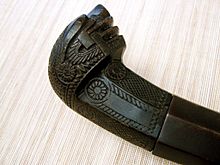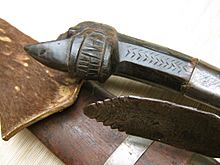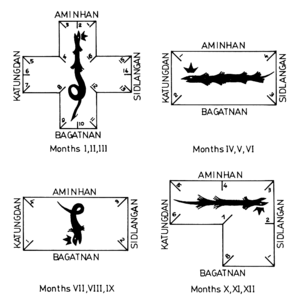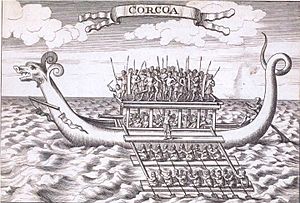Bakunawa facts for kids
 
Bakunawa pommels from Visayan tenegre swords
|
|
| Grouping | Dragon |
|---|---|
| Similar creatures | Sea serpent Phaya Naga Nāga Dragon (Asian) |
| Region | Visayas and Bicol regions of the Philippines |
The Bakunawa is a giant, serpent-like dragon from Philippine mythology. People in ancient times believed it caused eclipses, earthquakes, and even changes in weather like rain and wind. Its movements were thought to be a kind of calendar for old Filipinos. They also used it in special ceremonies led by their spiritual leaders called babaylan. The Bakunawa is often shown with a looped tail and a single horn on its nose. It was usually believed to be a sea serpent, but some stories say it lived in the sky or the underworld.
Over time, as people traded more with South Asia, the Bakunawa story mixed with ideas from Hindu and Buddhist mythology. It became linked to creatures like the Nāga, Rahu, and Ketu.
Contents
What Does "Bakunawa" Mean?
The name "Bakunawa" likely comes from two old words. These words mean "bent" or "curved" and "large snake" or "python." So, Bakunawa basically means "bent snake." You might also see it spelled as Vakonawa, Baconaua, or Bakonaua.
Old Stories About the Bakunawa
Long ago, people in the Philippines had a special way of explaining eclipses. A priest named Fr. Tomas Ortiz wrote about it in 1731. He said that when the moon was eclipsed, people would go outside. They would make a lot of noise by banging bells and pots. They did this to scare away the creature they believed was eating the moon.
They thought a dragon, tiger, or crocodile was swallowing the moon. For example, the Tagalog people would say, "Laho swallowed the moon." This shows how deeply this belief was part of their lives.
Other Myths Like Bakunawa
The Bakunawa is sometimes called Naga. This name comes from the Hindu-Buddhist mythology serpent deity, Nāga. It was also linked to Rahu and Ketu, who were gods believed to cause sun and moon eclipses.
Similar stories about eclipse-causing creatures exist in other parts of the Philippines:
- The Tagalog people have Laho, a serpent-like dragon that causes moon eclipses.
- In Kapampangan myths, Láwû is a bird-like dragon or serpent. It causes both solar and lunar eclipses. Both laho and láwû mean "eclipse" in their languages.
- Other related creatures include the Hiligaynon Bawa or Olimaw, the Mandaya Tambanakua, the Bagobo Minokawa, and the Maranao Arimaonga. These creatures don't always look like serpents. For example, the Arimaonga is a lion-like dragon, and the Minokawa is a giant bird.
Bakunawa in Mythology

Stories about the Bakunawa often explain why eclipses happen.
Cebuano Stories About the Moon Eater
Ancient Cebuanos believed their supreme god created seven moons. These moons lit up the sky beautifully. The Bakunawa, amazed by their beauty, would rise from the ocean. It would then swallow the moons whole. This made the supreme god angry, making them enemies.
To stop the Bakunawa from eating all the moons, ancient Filipinos would make loud noises. They would bang pots and pans to scare the Bakunawa. They hoped it would spit the moon back into the sky. Some people would play calming music. They hoped the dragon would fall asleep. Brave villagers then hoped to slay the dragon while it was hypnotized. The Bakunawa was known as both a "moon eater" and a "man eater."
Another story says the Bakunawa had a sister, a sea turtle. This turtle would visit an island to lay eggs. But each time she came ashore, the water seemed to follow her. This made the island smaller. Worried their island would disappear, the locals killed the sea turtle.
When the Bakunawa found out, it rose from the sea and ate the moon. The people were scared and prayed to the supreme god. The god didn't punish the Bakunawa. Instead, he told the people to bang pots and pans. The moon was then coughed up, and the Bakunawa vanished forever.
Some stories say the Bakunawa fell in love with a human girl. The tribe leader found out and burned their house. The Bakunawa became furious. It tried to get revenge by eating all seven moons. When it was about to eat the last one, the supreme god stepped in. He punished the Bakunawa by banishing it from its home in the sea. This story says eclipses happen because the Bakunawa is trying to return to its home and family.
Some Filipino elders believe the Bakunawa is a moving island with communities on its back. They say there are two types: a flying Bakunawa and a land Bakunawa.
West Visayan Tales of Bakunawa

The story of Bakunawa and the Seven Moons was first written down in 1913. It became more widely known in 1926.
According to old stories, when the god Bathala created the Moon, he made seven of them. Each moon was meant to light up one night of the week. The nights were bright and beautiful because of these "Queens" shining in the sky.
But this joy didn't last. One night, a scary creature coiled around the world. It was called Bakunawa. It was jealous of the beautiful moons and swallowed six of them. Only one moon was left.
When Bathala saw this, he planted bamboos on the last moon. From far away, these looked like "stains" on the moon's surface.
People were sad about losing six moons. They learned to protect the last one. One night, the whole world panicked. People screamed and banged drums and other objects. They saw the Bakunawa attacking the moon. Everyone, young and old, cried out, "Return our Moon!" This was the only sound heard that night. People feared the world would end if they lost their last moon. They came out of their homes and prayed. The loud noises stopped when they saw the Bakunawa finally spit out the moon.
The people were overjoyed when the moon returned. They praised the Almighty. Even today, many people still believe in the Bakunawa. Some still make noise during an eclipse, especially in mountain and coastal areas. This shows how old beliefs can stay alive.
Bicolano Stories of the Sea Serpent
In Bicolano mythology, Bakunawa is a giant sea serpent god of the deep and the underworld. It is often seen as the cause of eclipses.
One story says Bakunawa was once a beautiful goddess living at the bottom of the sea. She was amazed by a bright light. She went up and saw the moon, which was very beautiful. However, the moon did not return her feelings. So, she turned into a water dragon and tried to eat the moon instead. The moon's sister, Haliya, fought her off. This fight is said to cause the moon phases and eclipses.
Bakunawa in Songs
There's a short Hiligaynon song that children used to sing during lunar eclipses:
| Ang bulan namon sang una, sang una | Our moon long ago, long ago |
| Guin ka-on sang bakunawa | Was eaten by the bakunawa |
| Malo-oy ka man, i-uli, i-uli | Please have pity, return it, return it |
| Korona sang amon hari. | The crown of our king. |

Bakunawa in Art
You can find figures of the Bakunawa's head on the hilts (handles) of many old Filipino swords. These swords come from Panay. It was believed that these swords gave warriors the scary presence and power of the Bakunawa when they fought.
Bakunawa in Games
There's a children's game in the Philippines called Bulan Bulan, Buwan Buwan, or Bakunawa. It's played with 6–8 players in a circle.
One player is chosen as the buwan/bulan (moon). Another player is the Bakunawa (eclipse). The other players stand in a circle, holding hands. The buwan/bulan stands inside the circle, and the Bakunawa stands outside.
How to Play the Bakunawa Game
The goal of the game is for the Bakunawa to tag or touch the buwan/bulan. The players forming the circle try to stop the Bakunawa. They hold hands and run around the circle as fast as they can, without letting go.
To get into the circle, the Bakunawa asks a player, "What chain is this?" If the player says, "This is an iron chain," the Bakunawa must ask someone else. An iron chain is supposed to be unbreakable. A player who wants to let the Bakunawa in can say, "This is an abaca chain." This player then lets go of their hands. This usually happens when the Bakunawa player is tired from running.
The Bakunawa can also try to get in by going under the linked hands. If the Bakunawa player is fast and small, this can be easy. Once the Bakunawa gets inside, the players forming the circle should let the buwan out.
The Bakunawa then tries to break out of the linked hands to catch the buwan/bulan. If the Bakunawa catches the buwan/bulan, they switch places. Or, if both are tired, a new pair from the circle is chosen to be the Bakunawa and buwan/bulan.
Bakunawa in Pop Culture
- The Bakunawa appears as a superweapon in the video game Freedom Planet 2.
- In the mobile game EverWing, Bakunawa is one of the dragon sidekicks you can unlock.


